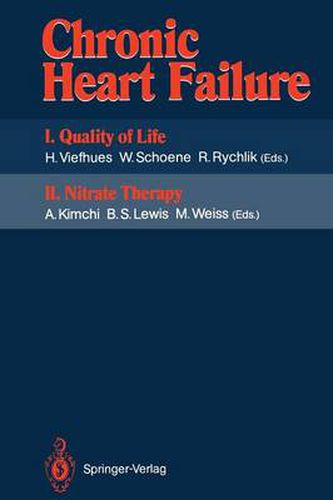Readings Newsletter
Become a Readings Member to make your shopping experience even easier.
Sign in or sign up for free!
You’re not far away from qualifying for FREE standard shipping within Australia
You’ve qualified for FREE standard shipping within Australia
The cart is loading…






This title is printed to order. This book may have been self-published. If so, we cannot guarantee the quality of the content. In the main most books will have gone through the editing process however some may not. We therefore suggest that you be aware of this before ordering this book. If in doubt check either the author or publisher’s details as we are unable to accept any returns unless they are faulty. Please contact us if you have any questions.
A. Schneeweiss Although the syndrome of congestive heart failure has been recognized many years ago, the approach for its evaluation and treatment has until recently, been partial and ‘fragmentary’. Various aspects of the disease have been treated according to the evaluation tools and therapeutic measures available at each period. This approach resulted in some of the greatest achievements in the management of heart failure but also left many aspects neglected and also resulted in several paradoxes. Examples of the achievements and limitations of the ‘fragmentary’ ap proach are the use of diuretics and hemodynamic measurements. The devel opment of diuretics has provided us with an important tool for helping pa tients whose predominant problem was edema. The success of diuretics masked the fact that their use may often be hemodynamically unsound and that they may reduce cardiac output. Only many years after their introduction has the use of diuretics found its appropriate place. Hemodynamic monitoring has gone via the same path. The great contribu tion of continuous bedside hemodynamic measurements to understanding heart failure resulted in over-usage by many clinicians, who found themselves treating hemodynamic charts rather than patients. It took almost a decade to realize that hemodynamic improvement, even in the chronic setting, does not necessarily mean symptomatic improvement or an increase in exercise capac ity.
$9.00 standard shipping within Australia
FREE standard shipping within Australia for orders over $100.00
Express & International shipping calculated at checkout
This title is printed to order. This book may have been self-published. If so, we cannot guarantee the quality of the content. In the main most books will have gone through the editing process however some may not. We therefore suggest that you be aware of this before ordering this book. If in doubt check either the author or publisher’s details as we are unable to accept any returns unless they are faulty. Please contact us if you have any questions.
A. Schneeweiss Although the syndrome of congestive heart failure has been recognized many years ago, the approach for its evaluation and treatment has until recently, been partial and ‘fragmentary’. Various aspects of the disease have been treated according to the evaluation tools and therapeutic measures available at each period. This approach resulted in some of the greatest achievements in the management of heart failure but also left many aspects neglected and also resulted in several paradoxes. Examples of the achievements and limitations of the ‘fragmentary’ ap proach are the use of diuretics and hemodynamic measurements. The devel opment of diuretics has provided us with an important tool for helping pa tients whose predominant problem was edema. The success of diuretics masked the fact that their use may often be hemodynamically unsound and that they may reduce cardiac output. Only many years after their introduction has the use of diuretics found its appropriate place. Hemodynamic monitoring has gone via the same path. The great contribu tion of continuous bedside hemodynamic measurements to understanding heart failure resulted in over-usage by many clinicians, who found themselves treating hemodynamic charts rather than patients. It took almost a decade to realize that hemodynamic improvement, even in the chronic setting, does not necessarily mean symptomatic improvement or an increase in exercise capac ity.